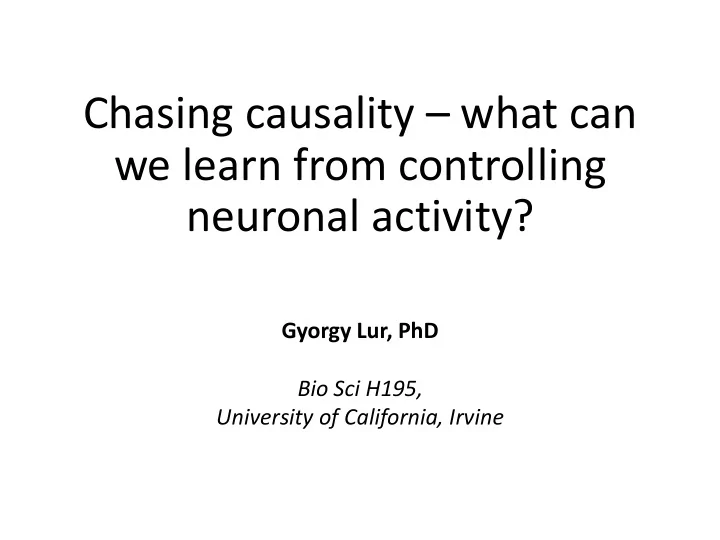

Chasing causality – what can we learn from controlling neuronal activity? Gyorgy Lur, PhD Bio Sci H195, University of California, Irvine
Necessary and sufficient A -> B -> C A -> X -> X B is necessary A -> X -> C B not necessary X -> B -> C B sufficient X -> B -> X B not sufficient In formal logic: true N&S is that it implies equivalence between the two statements, allowing one to be a definition of the other → indispensable and inducing Yoshihara & Yoshihara 2018
What’s the point? To establish causality observation is not sufficient, we need to manipulate brain activity The scientific method : hypothesis -> experiment Causality vs correlation http://www.tylervigen.com/spurious-correlations
The lack of pirates caused global warming!
How do we test causality? Manipulate brain activity in a controlled manner … GLHF … Distributed hierarchical processing in primate visual cortex . Felleman, D.J. and Van Essen, D.C. (1991) Cerebral Cortex, 1: 1-47
How to control neuronal activity 1. Lesion 1. TBI 2. Stroke 3. Artificial (phototrombic) stroke 4. Freezing 2. Inactivation 1. Pharmacology 1. Permanent (e.g.: N -methyl-dl-aspartic acid) 2. Temporary (e.g.: muscimol) 2. Cooling 3. Pharmacogenetics (DREADDS) 4. Light 3. Activation 1. TMS 2. Electrical stimulation 1. Peripheral (e.g: driving a cockroach) 2. Central stimulation of brain regions 1. During surgery 2. Parkinson's treatment (DBS) 3. Pharmacogenetics (DREADDS) 4. Light
History of inactivation is a history of injuries ~1600 BC: Edwin Smith Papyrus: classification of head injuries 1850’s: Phineas Gage: severe, possibly temporary personality change 20 th century: lesion studies causes: injury, inflammation, tumor, ischemic stroke etc. frontal lobotomy to “cure” mental illness epilepsy: corpus callosotomy (Dr. William P. van Wagenen and Roger W. Sperry)
The Legacy of Patient H.M. for Neuroscience – Squire 2008 Loss of recent memory after bilateral hippocampal lesions. SCOVILLE WB, MILNER B, 1957 - Patient H.M.: severe epilepsy following childhood bike accident - Treatment: bilateral hippocampal lesion at age 27 (actually: hippocampus, amygdala, and the adjacent parahippocampal gyrus) - “side effect”: severe memory impairment: no memory consolidation - intact intellectual and perceptual functions
Brain lesions studies in humans in the 21 st century Goal: link an identified brain region to function in behavior Value: there are not many non-invasive ways to manipulate neuronal activity in humans, lesions are a crucial tool supplementing imaging approaches. Difficulty: old lesion studies provide inaccurate descriptions modern lesion studies: often single patient, huge variability, no reproducibility, thus the data may not generalize Solutions: increased sample sizes (USA: 800,000 diagnoses of stroke) combination with imaging methods for better documentation meta-analysis algorithms for better statistical power What can be tested: 1) Are brain networks redundant (several options for same function)? 2) What happens to brain networks (fMRI) when a node is lesioned?
Controlled inactivation 1. Pharmacology 1. Permanent (e.g.: N -methyl-dl-aspartic acid, phototrombic lesion) 2. Temporary (e.g.: muscimol) 2. Cooling 3. Pharmacogenetics (DREADDS) Goal: is this bran region / neuronal population “necessary”? Approach: 1-2: non-selective, larger region 3: can be cell specific (Cre-loxP system) TTC (2,3,5-triphenyltetrazolium chloride) staining visualizes hypoxic brain tissue
Altering behavior via temporary inactivation of brain regions 24h later Trace and contextual fear conditioning are impaired following unilateral microinjection of muscimol in the ventral hippocampus or amygdala, but not the medial prefrontal cortex . Gilmartin et al., 2012
Inactivating specific synapses with DREADDs Chemogenetic Synaptic Silencing of Neural Circuits Localizes a Hypothalamus→Midbrain Pathway for Feeding Behavior . Stachinak et al., Neuron 2015
Controlled activation of neurons 1. TMS 2. Electrical stimulation 1. Peripheral (e.g: driving a cockroach) 2. Central stimulation of brain regions 1. During surgery 2. Parkinson's treatment (DBS) 3. Pharmacogenetics (DREADDS) Goal: is this bran region / neuronal population “sufficient”? Approach: 1: can be reasonably constrained with small electrodes or in specific brain regions (nuclei) 2: can be cell specific (Cre-loxP system)
Transcranial magnetic stimulation Non-invasive (can be used in humans) Changing magnetic field generates electrical current via electromagnetic induction Has diagnostic and therapeutic potential, but may cause seizures and fainting. Causes severe physical discomfort. “Some of the studies have shown promising but not conclusive evidence for the efficacy of TMS in depression. But TMS has not been shown to be effective in the treatment of obsessive compulsive disorder, posttraumatic disorder, or schizophrenia. The patient sample size has been a cause of concern in most studies.” Basil et al 2005.
Electrical brain stimulation Electrical discharges delivered to defined brain areas in awake patients Goal is to map their functional involvement in sensation and movement, or cognitive functions such as language and memory. Electrical stimulation of the human brain: perceptual and behavioral phenomena reported in the old and new literature. J Parvizi 2010
Electrical activation: antidromic identification of neuronal projections
DREADD activation increases water and salt consumption DREADD-induced activation of subfornical organ neurons stimulates thirst and salt appetite. Nation et al. 2016
In any inactivation experiment, what we really study is how the rest of the brain compensates for the loss of a functional part of the nervous system
Recommend
More recommend